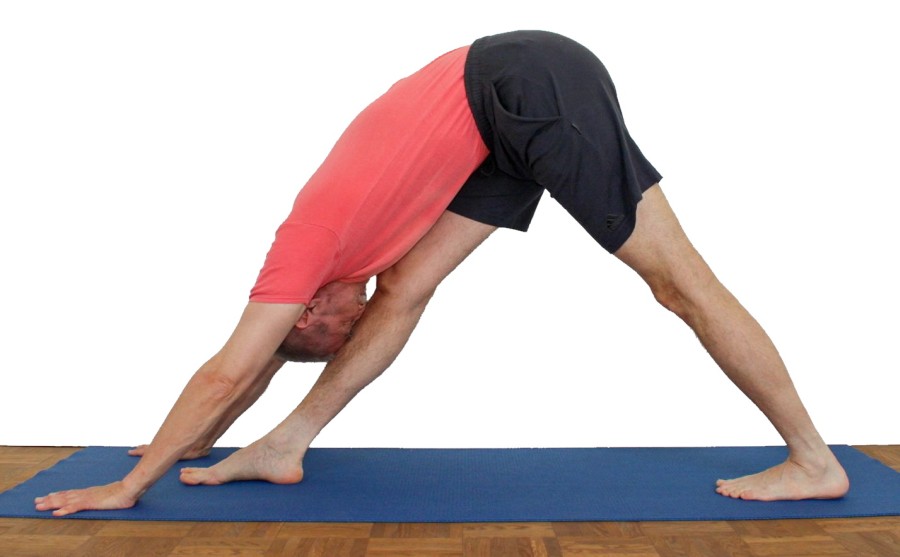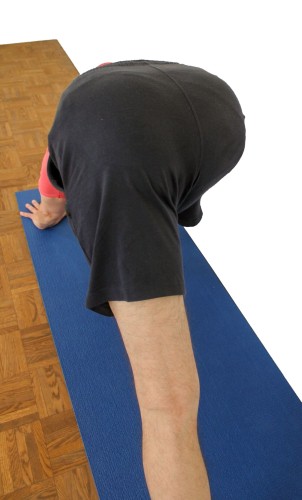yogabook / asanas / hip opener 5
Contents
„hip opener 5“

 instructions and details with working links as PDF for download/print
instructions and details with working links as PDF for download/print
Detailfotos
Becken gerade |
Feedback: We’d love to hear what you think about this description, give us feedback at:
postmeister@yogabook.org
Last modified: 30.12.2018
Trivial name: hip opener 5
Level: FA
- classification
- contraindications
- effects
- preparation
- follow-up
- derived asanas
- similar asanas
- diagnostics
- instructions
- details
- variants
Classification
classic: opse on the floor
physiological: one-sided, intensive stretching of the hamstrings
Contraindication
Herniated discs (and bulging discs) in the lumbar spine are an important contraindication, as the back is clearly bent in this pose, the less mobile the hamstrings, the more so.
Another important contraindication is PHT (Proximal Hamstring Tendinopathy), as a large partial body weight with a good gravitational effect (on average more or less horizontal direction of the upper body) rests on the tendons of the hamstrings.
Effects
- (872) Strengthening some pronators of the ankle joint
- (712) Mildly stretching the short hip extensors (especially the gluteus maximus).
- (721) Strongly stretching the hamstrings
- (841) Stretching the dorsiflexors of the ankle
Preparation
As this pose is one of the best and most far-reaching stretches of the hamstrings, there are many posts that are suitable as preparation:
- uttanasana as a generally effective and efficient stretch of the hamstrings to prepare for flexion in the hip joint in this pose
- prasarita padottanasana very similar to uttanasana
- parsvottanasana as a stretch that goes beyond uttanasana
- pascimottanasana
- janu sirsasana
- tryangamukhaikapada pascimottanasana
- downface dog as another good preparation for the hamstrings when the pelvis is tilted powerfully
- warrior 3 pose, also in the variation backwards against the wall
- trikonasana
- parivrtta trikonasana
The hip extensors in/around the pelvis (e.g. gluteus maximus) may also place a restriction on flexion in the hip joint, in which case practise:
- half lotus forward bend
- hip opener at the edge of the mat
- hip opener 3
- parivrtta trikonasana, preferably with the standing leg bent and hips dropping
- parivrtta ardha chandrasana, best with bent beach leg and falling hips
In addition to baddha padasana, this is another very effective exercise for stretching the dosriflexors of the foot; it can be prepared with.
- baddha padasana is probably the most precise exercise for plantar flexion in the ankle joint
- virasana also achieves this if attention is paid to the extension of the ankle joint
- supta virasana also achieves this if attention is paid to the extension of the ankle, but has other, greater challenges
Follow-up
Derived asanas:
Similar asanas:
Diagnostics (No.)
As in many other forward bending movements (flexion in the hip joint in one/both hip joints), various disorders can be found in the musculature of the hamstrings:
- Shortening of the hamstrings, see FAQ.
- Damage to the hamstrings that causes pain or functional limitations can also be easily recognised here, from simple tension to strains to muscle tear (partial or complete). Tears may lead to a reduction in strength when leaving the pose quickly.
- Irritation of the sciatic nerve: irritation of the sciatic nerve, which innervates the leg and foot, can become symptomatic during forward bends in particular, even if they are otherwise rather calm. See the FAQ.
- Irritation of the origin of the hamstrings at the ischial tuberosity (also known as PHT: Proximal Hamstring Tendinopathy) will be particularly evident in this pose and require protection from the intensive stretching that this pose demands; see the FAQ.
- Baker’s cysts create a feeling of tension or a foreign body, see FAQ.
(841) Stretching the dosriflexors of the foot in the front leg:
Wide plantar flexion occurs in the ankle joint of the front leg when the distance between the feet is wide, stretching the foot lifts, especially the tibialis anterior and extensor hallucis longus. Especially when the extensor hallucis longus is shortened, there is a clear inclination of the foot towards supination and a lifting of the big toe off the ground. If these effects also occur at a moderate distance, this indicates pronounced shortening.
(856) Stretching of the gastrocnemius in the rear leg
Especially when the distance between the feet is large, it is often no longer possible to place the rear heel on the ground, resulting in a marked stretch in the gastrocnemius. But even if it can be placed on the ground, a significant stretch can occur there. Any excess of stretching sensation indicates a fairly contracted muscle. It is also possible that qualitatively different stretching sensations indicate a pulled muscle, for example.
(880) Hyperextension of the knee joint in the front leg:
Hyperextension of the knee joint refers to the ability to take an angle or the current state of an angle of more than 180° in the knee joint. To a certain extent, this is considered normal by anatomists and is on average more common and more pronounced in women. However, it can also indicate a weakness of the hamstrings or the quadriceps. It is also not uncommon for unphysiological sensations to occur during hyperextension that are not caused by stretching or straining the muscles and should be avoided, see also FAQ.
(913) Cramp in the muscles of the sole of the foot or calf:
In this pose, the sole of the foot is compressed, cramps in the sole of the foot can indicate previous (even chronic) incorrect strain and shortening of the muscles. Highly toned calf muscles can be prone to cramps, as both the monoarticular soleus and the biarticular gastrocnemius work close to their active insufficiency, i.e. at an extremely short sarcomere length.
Variants:
Instructions
- Take downface dog.
- Bring the right foot forwards, approximately in the centre between the hands (i.e. the heel at wrist height).
- Press your upper body as close as possible to the thigh of the front leg.
- Maintain the contact you have just made and now slowly extend the front leg so that contact is not lost or at least the distance remains as small as possible.
Details
- The front leg tends to turn out, prevent this by moving the inner knee downwards forcefully from the hip joint and pressing the metatarsophalangeal joint of the big toe firmly onto the floor, which means that the externally rotating evasive forces in the hip joint are countered by a conscious internally rotating force and the foot is not allowed to supinate according to its inclination, but is pressed onto the floor with the necessary pronatory force in its inner area.
- Since muscles such as the tibialis anterior and extensor hallucis longus are not only dorsiflexors but also supinators, the front inner foot tends to become lighter and lift off the ground. Therefore, consciously press the metatarsophalangeal joint of the big toe onto the floor using the strength of some calf muscles in order to achieve complete stretching of the above-mentioned muscles, which also makes it easier to correct the evasive twisting movement of the thigh in the knee joint, as the knee joint does not allow rotation when fully extended. Depending on the flexibility restriction of the dorsiflexors and toe extensors, the ball of the inner foot becomes light and a very intense stretch may be felt in these muscles. If this restricts the forward bend in the hip joint of the front leg, the distance between the feet can be reduced to such an extent that although stretching is still felt in the dorsiflexors of the ankle and the toe extensors, the forward bend is no longer impaired. If this compromise is difficult to achieve, the ball of the foot can also be raised to a moderate height, which can be necessary especially in cases of ankle impingement. However, this rather rare opportunity for precise and intensive stretching of the targeted muscles should not be given away lightly. Even with baddha padasana, a similarly intense stretch is only just possible, and this pose, however precisely it stretches the ankle, also tends to cause quite significant pressure at various points on the inner foot. For postures with virasana leg(s) such as virasana itself, supta virasana, krouncasana and tryangamukhaikapada pascimottanasana, it is important to stretch these muscles to prevent the foot from moving into adduction in the ankle joint and causing an undesirable rotation of the lower leg in the knee joint.
- The back leg remains like in the downface dog, i.e. the foot points straight backwards and the heel moves towards the ground.
- It is possible for almost all people to establish more or less strong contact between the thigh and upper body after the leg has been pulled forwards, but for beginners and people with little flexibility in the hamstrings in particular, it is often not possible to maintain this contact when extending the front knee; it is often lost after the first 20° of extension in the knee joint (compared to the starting position with the upper body on the thigh).
- The hip belonging to the front leg should be moved backwards and upwards so that both hips are at the same height and the same distance forwards during the pose. Once the pelvis evaded, this correction can cause a significantly greater sensation of stretching, and the evasion is often associated with a lateral curve of the upper body (lateral flexion of the spine), which is performed as a surrogate movement.
- This pose is easier to perform if intensive forward bends like uttanasana are performed beforehand.
- The forehead can be placed on the lower leg and remains there while the leg is extended.
- In this pose too, move both feet away from each other.
- In this pose, you basically have the choice of either fully extending the front leg and accepting that the upper body will detach from the thigh and move away or maintaining this contact as much as possible and not being able to extend the front knee. In both cases, a comparably intensive stretching of the hamstrings can be achieved. Option one, stretching the leg in any case, is the more interesting, as in many cases this also results in a good stretching of the dorsiflexors of the ankle. As poses in which these can be stretched as intensively as here are rather rare, you should take the opportunity to do so!
- Stretch the upper body as far as possible. It is neither the aim nor possible to keep the upper body fully stretched, but with regard to the strain on the lumbar spine, the gravitational effect of the upper body and the resulting stretching of the hamstrings, the best possible stretch is desirable.
Variants
Ball of foot elevated

Purpose: To relieve the foot lifts of the front leg if their stretch sensation too clearly outweighs that in the ischiocrural group. This variant is also recommended if extension is restricted in the anterior knee joint due to an ankle impingement in the anterior leg.
Instructions
- Take the pose as described above, but place the balls of the feet on an elevation which should be chosen so low that just enough relief is achieved in terms of stretching the dorsiflexors so that the forward bend in the hip joints is not impaired.
Details
- This pose implements the relief described in the details of the basic pose.
